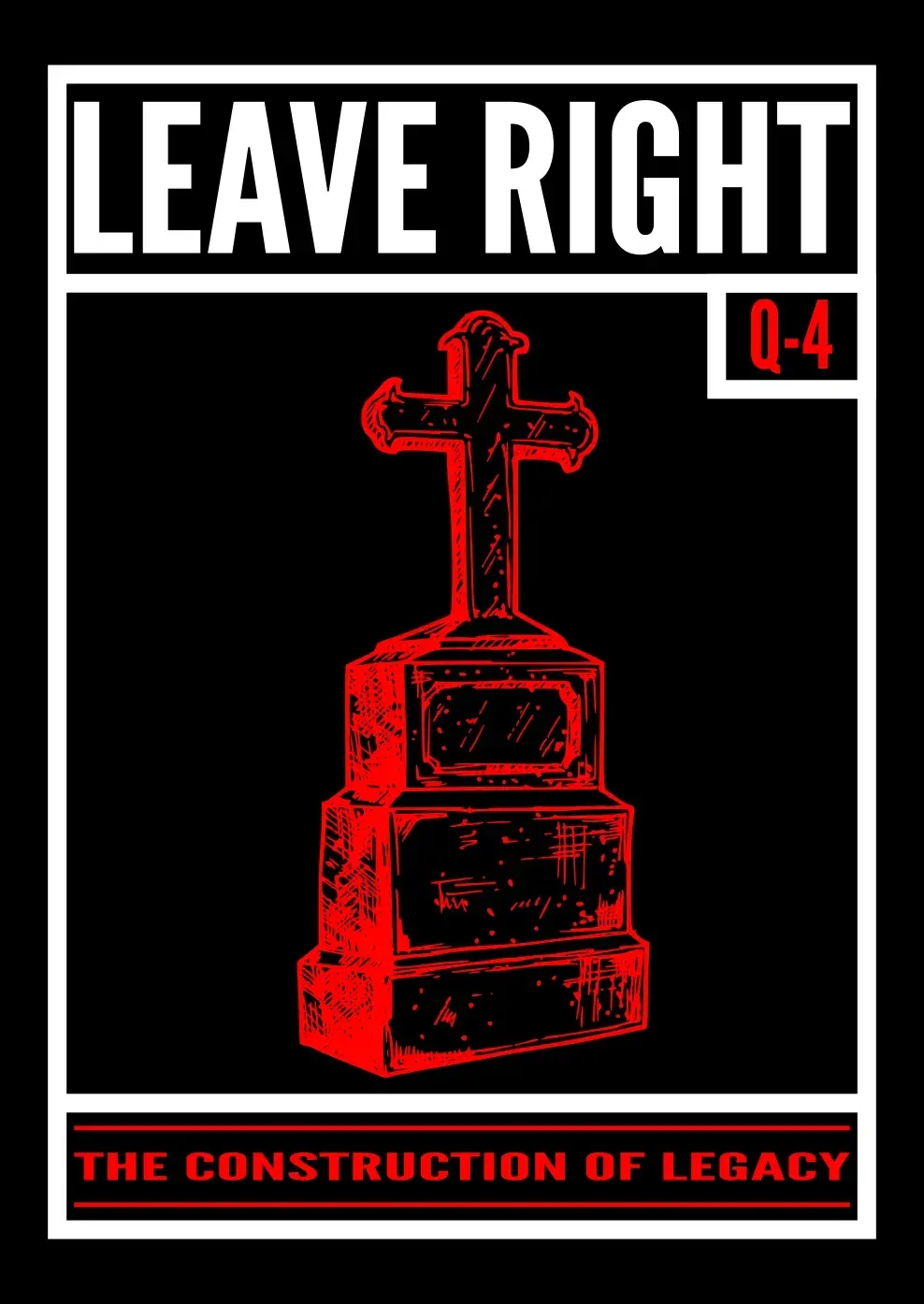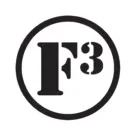LEAVE RIGHT (Q4)
The Construction Of Legacy
Only a Virtuous Leader can leave a Legacy
The Leave Right is the fourth quadrant of the G3L. In the first quadrant we explored what a man must do to Get Right, to be in proper personal alignment. In the second quadrant we discussed what it means for a HIM to Live Right through dedication to Purposefulness. In the third quadrant we outlined the Practice of Virtuous Leadership that is required to Lead Right. Now, having arrived at the fourth and final quadrant of the G3L, we take on the Leave Right, which is a Virtuous Leader’s construction of Legacy.
Legacy is what a Virtuous Leader leaves behind through the Effective performance of his Mission, which is the Course Of Action he pursues to achieve his Ultimate Purpose. A man’s Legacy has two components:
– The Advantage he achieves for his Groups through his Virtuous Leadership, and
– The development of other men into Virtuous Leaders who will also seek Advantage for their Groups
Advantage is a superior circumstance achieved by Movement. It is a change to the Status Quo that puts a Group into a better position than it would have otherwise been. Advantage results from a Virtuous Leader’s application of the Leadership Skills that enable him to initiate Movement to a specific Vision that he has Articulated, and to maintain Momentum through the Obstacles that will ultimately appear along the way. A man’s Legacy will be a direct result of the nature and magnitude of the Visions that he shepherds into fruition during his lifetime. Bigger Visions result in more robust Advantages, which in turn form the building blocks of a HIM’s Legacy.
A man’s Legacy is not comprised simply of what a he happens to say and do during his lifetime. For most of us that will all be forgotten, and much more quickly than we want to believe. Rather, Legacy is constructed through the people a man has intentionally Influenced during his life and the Problems that he deliberately set out to solve–all compounded by his love and generosity of heart in passing on what he knows.
Leave Right is the last quadrant of the 3GL because the construction of Legacy requires Virtuous Leadership. It is the result of a lifetime of Mission accomplishment through Living Right and Leading Right, neither which is possible unless a man has first Gotten Right.
There are no shortcuts.
A HIM seeks the solution to his Ultimate Life Problem
A Problem is a Disadvantage that both can and must be remedied. If the Disadvantage cannot be remedied than it is not a Problem, it is a Condition to which the person or Group must learn to adapt. Likewise, if the Disadvantage (however vexing) is not something that must be remedied for full Effectiveness, than it is also not a Problem–it is a Deck Chair (rather than an Iceberg ), something that might be improved upon, but only after all the Problems have been solved.
The HIM doesn’t waste his life flailing at Conditions that will never change no matter what he does. Nor does he fritter and waste his hours rearranging Deck Chairs while Icebergs loom ahead. That is the province of the Mascot whose objective is only to seem like a man who Influences Movement to Advantage rather than to actually be one. Instead, because he is a Virtuous Leader, the HIM focuses his time and energy on solving his ULP , that particular Problem that he was uniquely born to solve. He does this through the Effective accomplishment of his Mission.
Mission building is a four-step process. First, the HIM identifies his ULP. Second, he devises the Solution to his ULP that is most reasonably calculated to remedy the Problem. Third, he maps a Course Of Action to effectuate his Solution. Finally, he enlists the aid of others in the accomplishment of his Mission by Influencing them to Move toward the Advantage his Solution provides.
The larger the ULP is, the more difficult the Solution will be and the more people it will take effectuate it. Leaders who Influence the most people to join them in solving the largest Problems leave behind the biggest Legacy. Thus, while a Solution itself may be the result of a HIM’s sole Vision, its successful implementation will not be. That will require the collective efforts of the Effective Organizations the HIM builds and the Dynamic Teams that he forms and deploys too accomplish his Mission.
– Identifying The ULP
Every person is born with a ULP and identifying it is not very difficult. It is simply the recognition of the overarching Disadvantage that nags at a man (more than any other Problem) his entire life. Identifying one’s ULP really just means abandoning the exhausting effort expended trying to ignore it.
For example, my ULP is dormant Male Community Leadership. Chronic Sad Clown Syndrome and rampant Mascotry have bugged me since I was a boy. Yet it wasn’t until I was forty-three years old that I admitted this Truth to myself. This led to me to the revelation that I was a Sad Clown and a Mascot, in the worst way. My ULP, at least initially, was me. Before I could become Missional, I had to Get Right, and that took some time.
What nags at you more than any other Problem? Maybe it’s global warming or adult onset diabetes. If so, that’s your ULP and accepting that is the first step to building your Mission.
– Devising The Solution
Purpose is Advantage sought, the reason to do what is done. The Solution to a HIM’s ULP is his capstone Advantage, and the Movement required to get there is his Ultimate Purpose. It acts as the lodestar as his life as a Leader.
Just as each person’s ULP is unique, so is the Ultimate Purpose he must devise if he wants to remedy it. Each of us has the choice to live our lives frustrated by our ULP or to live with Missionality, seeking the Advantage that will solve it. People who live to their Ultimate Purpose leave a Legacy. Those who don’t live their lives as Amateurs who react emotionally to their circumstances rather than deliberately engaging in the Movement required to change them.
Because they prioritize Happiness over Joy they focus on themselves rather than their Creator and Community. Upon death, they are quickly forgotten–or worse, they leave behind a trail of bitter disappointment.
To divine his Ultimate Purpose a man need only to flip his ULP on its head. Thus, my ULP being dormant male Community Leadership, my Ultimate Purpose is to reinvigorate Male Community Leadership. Likewise, if a man’s ULP is global warming, his Ultimate Purpose might be to reduce man’s carbon emissions. Or, if it is adult onset diabetes, his Ultimate Purpose might be to evoke healthier lifestyles.
Whatever your ULP might be, seek it with all your heart.
– Mapping A Course Of Action
Once a HIM has devised his Solution he is ready to initiate Movement toward his Ultimate Purpose by developing an integrated scheme of Tasks and Events. Tasks are actions performed and Events are things that occur. Together, they form a HIM’s Course Of Action, the Waypoints on the path to Advantage.
Because it is easy, most people will come to know their Ultimate Purpose, they just won’t do anything about it because doing (the Course Of Action) is the hard part. Doing starts with Living Right through dedication to Purposefulness. The HIM Serves within the High Impact Zone (the HIZ) that is formed by his D2X, which is the intersection his Dolphin and Daffodil. The Dolphin is the Task a person was born to do best, and the Daffodil is the people-group he was born to Serve. The D2X is the sweet spot where the HIM will have the most IMPACT if he lives in difficult and dangerous disregard of the risk of Failure. The Events that occur on the path to Advantage are the direct result of a HIM’s determination to serve within his HIZ.
Only by mapping out a Course Of Action will you be able to Move toward Advantage.
– Enlisting The Aid Of Others
The HIM combines with other people in Groups in order to accomplish his Ultimate Purpose. He does this by developing Dynamic Teams and building Effective Organizations.
A Team is a Proximate combination of two or more people formed to perform a specific Mission for the benefit of a Community, an Organization or both. To be Dynamic, a Team must be energetic, vigorously active and forceful.
An Organization is a Group of two or more people that voluntarily combine for the accomplishment of an Articulated Purpose. To be Effective, an Organization must be Purposeful.
Like a HIM, a Dynamic Teams and Effective Organizations are focused on the accomplishment of their Mission. However, there is a difference in the way Mission is formed between a HIM and a Group. Where the Mission of a HIM is the combination of what he does (his D2X) and the reason he does it (his Ultimate Purpose), the Mission of an Organization or Team is the combination of what it does (its Task) and the reason it does it (its Articulated Purpose). Thus:
– For the HIM, D2X + Ultimate Purpose = Mission
– For Groups, Task + Articulated Purpose = Mission
For a HIM’s Legacy to grow, his personal Mission must align with the Mission of the Groups in which he is a Member. For example, my Mission is to teach and lead Accelerating Men in order to invigorate Male Community Leadership. F3, an Organization of which I am a Member, has as its Mission to plant, serve and grow men’s small workout Groups in order to invigorate Male Community Leadership. My Mission not only aligns with the Mission of F3, but directly advances it because my Ultimate Purpose is the same as F3’s Articulated Purpose and my D2X is a necessary component of F3’s Task. Thus, when I am working within my D2X toward my Ultimate Purpose, I am also in service to the Articulated Purpose of F3.
If it were otherwise, I would be a Toxic in that my Mission was inconsistent or inimical to F3’s Mission, I would be working at cross-purposes with my Group and Legacy would be impossible.
Legacy is constructed through the HIM’s development of Virtuous Leaders
Within the Virtuous Leader there is a strong integration of thought and action, what F3 calls the Leadership Foundation. It is the the Dynamic product of a HIM’s excellent Leadership Skills and the high degree of Leadership Virtue that he possesses. The Leadership Foundation is what the HIM relies upon to maintain Joy through Hardship and chart the proper path through the Obstacles that his Groups will periodically encounter.
Every man is born with some innate Leadership ability, just as every man with functioning limbs has some innate athletic capability. But just as no man can reach his full athletic potential without training to develop it, neither can he can he realize his full potential as a Leader without a development process that builds his Leadership Foundation. Trying to Lead without one is like living in a house built upon shifting sand–neither will survive the heavy rains of Hardship that eventually afflict us all.
F3’s Leadership Development Process (LDP) has four phases:
– Schooling: the phase of an LDP during which formal Leadership instruction is provided. This is where a man is taught the head knowledge of who a Leader is supposed to be and what he is supposed to do.
– Apprenticeship: the phase of an LDP within which Positive Habit Transfer takes place. This is where the new Leader’s head knowledge is turned into hand knowledge through application under the direction of a more experienced Leader.
– Opportunity: a position within a Group that provides a man with Leadership experience as part of an LDP through direct responsibility for Outcome.
– Failure: undesirable Outcomes that build the Leadership Foundation through the increase of the Leader’s Durability.
It is through the four phases of the LDP that a man learns to be what a Leader is and do what a Leader does. The LDP provides head knowledge, transforms it into hand knowledge, provides a place to test it and the chance to learn from doing it wrong. Without all four phases, it is unlikely that a man will reach his full potential as a Leader because his Foundation will be weak or incomplete. When faced with Obstacles, Pain or Chaos he will have nothing to rely upon because he lacks an integration of thought and action.
Before we describe each building block of the Leadership Foundation in detail, we need to make some general points.
First, we say it is unlikely that a person will reach their full potential without each of the phases of the LDP because we are not quite willing to say that it is impossible to do so. A man may have so much innate Leadership ability that the lack of formal Schooling (for example) does not significantly hamper his overall development. He could be a self-taught Leader in the way a truly talented musician might learn how to play an instrument by ear. Still, without Schooling, he will be like a piano player who never learned to read sheet music. Good, maybe very good, but never great. There are some beneficial Leadership lessons that just cannot be self-taught.
Second, F3 does not specify a prescribed sequence for the phases of the LDP. We do not contend that Schooling must precede Apprenticeship, to be followed by Opportunity with Failure being the last brick laid upon the Foundation. In fact, the four blocks can (and often are) laid both simultaneously and repeatedly. This last statement will make more sense as we explain each phase in detail. For now, we want to be clear that there is not a rigorous sequence. A Leader who realizes that he has never received any formal Schooling can certainly improve by obtaining some even though he has already had ample Opportunity and Failure. In fact, the desire to shore up one’s Leadership foundation is something done by the Virtuous Leader.
That being said, the absence of a rigorous sequence does not mean that there is no ideal sequence for the LDP. We have not listed the phases randomly such that Failure could just as well be first and Apprenticeship last. Ideally, Schooling leads to an Apprenticeship followed by Opportunities to lead that result in Failures from which the developing Leader forms his full Foundation. The building blocks in this ideal sequence would have significant overlap and simultaneous construction, such that (particularly while the man is going through it) it is difficult to discern the precise block being laid at any particular time. It is only in retrospect (as we are doing now in the writing of this book) that a developed Leader can see how his own particular Foundation was laid.
Finally, the building of the Leadership Foundation is a never-ending process in the HIM’s life. If he thinks the structure is complete so that he can put aside his trowel and mortar for good he has unwittingly begun the process of its deconstruction. Just as a man’s Fitness provides no opportunity for plateaus (because a man is becoming either marginally more or less fit every day) a man’s Leadership Foundation never reaches a point of perfection where no further work is required.
Each day, a Leader’s Foundation grows a little stronger or a little weaker depending upon his willingness to steadily keep building it.

Additional Study Materials
Socratic
How does Legacy come about?
Is a man’s Legacy preordained?
What role does Leadership development play in Legacy?
Spur
Only a Virtuous Leader can leave a Legacy
A HIM seeks the solution to his Ultimate Life Problem
Legacy is constructed through the HIM’s development of Virtuous Leaders
Additional Resources


Facebook
Instagram
X
LinkedIn